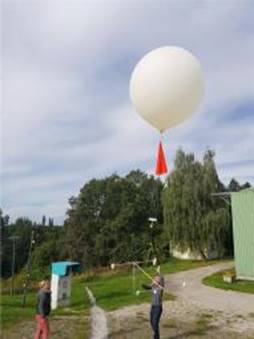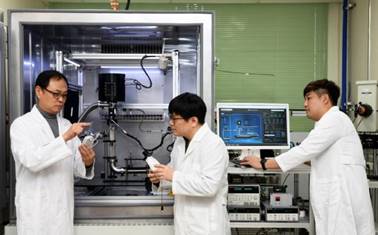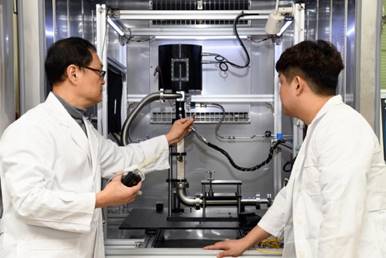
News & Updates
Laboratory generated atmosphere increases accuracy of meteorological observations
- Writerkrissadmin
- Date2019-02-01 00:00
- Hits11881
Laboratory generated atmosphere increases accuracy of meteorological observations
- Development of earth atmospheric temperature measurement accuracy assessment technology-
# How do meteorologists observe phenomena high up in the sky? They use radiosondes, which are telemetry instruments that float high up in the sky on balloons, reaching approximately 35 km above the ground, to measure meteorological conditions such as temperature, humidity, and atmospheric pressure. A radiosonde comprises a sensor and a transmitter, and has the advantage of low cost and weather and daylight independent observation.
A team at the Korea Research Institute of Standards and Science has successfully developed technology for evaluating meteorological observation systems in an environment identical to the actual atmosphere, to improve the accuracy of observations.
The KRISS upper air measurement team* has developed an aerological simulation system that can simulate and precisely control meteorological elements such as temperature, humidity, air pressure, solar radiation, and wind speed. In addition, the team has also developed technology for evaluating a radiosonde’s temperature measurement capability to an accuracy of 0.1 ℃ based on the simulation system. Using this technology, accurate temperature measurements can be taken from the stratosphere up to 35 km above ground. This means that the biggest uncertainty in climate change forecasting, directly associated with global warming and fine dust pollution, can be eliminated.
* KRISS upper air measurement team: A transdisciplinary research team comprising Principal Research Scientist Yong-gyoo Kim of the Center for Thermometry and Fluid Flow Technology and 10 experts in the fields of temperature, humidity, flow, and photometry.
Temperature is a key primary indicator directly related to climate change. Temperatures in the troposphere up to 10 km ~ 15 km above ground, where air circulates, are used to forecast short term weather trends, while temperatures in the stratosphere remain stable, and are used in long term climate change monitoring.
Stratospheric meteorological observations are usually made by attaching radiosondes to balloons. However, unlike on ground, the wind and solar radiation in the stratosphere interfere with the accuracy of temperature measurement. This is why temperature sensors have to be calibrated so that the reading matches the actual measured value.
Until now, it was difficult to evaluate radiosonde measurements accurately, as there was no internationally recognized method or standard to calibrate the sensors while considering the various meteorological factors. The biggest challenge when calibrating sensors in the lab was generating constant wind. In the low temperature and pressure conditions of the upper air, the desired wind ventilation speed cannot be generated by the use of simple fans alone.
The KRISS team has developed an ‘upper air simulation system’ and ‘temperature calibration technology’ that allow precise calibration of radiosondes for various ventilation speeds and solar irradiance under a wide range of meteorological conditions. For the first time in meteorological simulations, the team introduced the sonic nozzle*, which sends air flowing at a constant speed under specific conditions to generate wind.
* Sonic nozzle: Specific pressure conditions can be created by making the outlet of the tube, through which air flows, smaller than the inlet. Sonic nozzles are used to keep the amount air being released through the tube flowing at a constant rate.
The system comprises a large chamber installed with a sonic nozzle and air pressure control device to control the temperature and air ventilation speed. Using the system, radiosondes can be precisely calibrated for altitudes up to 35 km and a minimum temperature of –70 ℃, to an accuracy of 0.1 ℃. This is a high level of precision never before reached in any country around the world or even by the World Meteorological Organization(WMO).
“Radiosondes, which are widely used by the meteorological administration and air force, can now be evaluated according to a national standard,” says Principal Research Scientist Yong-gyoo Kim who leads the team, adding, “this will not only improve the reliability of meteorological observation in the country, but also create a foundation for the domestic production of radiosondes, allowing Korea to achieve advanced nation status in meteorology.”
This research was funded by the KRISS institutional program and the Ministry of Trade, Industry and Energy’s Core Industrial Technology Development Project. Its outcomes were presented at the WMO CIMO-TECO* conference.
* WMO CIMO-TECO: Biannual conference held by the WMO, with the participation of Meteorological Administrations and meteorologists around the world.
○ Radiosonde

▲ KRISS team is conducting joint research with the German Meteorological Service (DWD) for radiosonde evaluation
- Meteorological observation device that can transmit upper air essential climate variables such as temperature, humidity, air pressure, wind direction, wind speed, ozone concentration, etc., to the ground via radio frequency telecommunication. It is composed of various meteorological observation sensors such as temperature sensors and a GPS module. It is sent up into the sky on a large balloon about 2 m in diameter, and reaches a maximum altitude of 35 km at a speed of 5 m/s, where it takes a wide range of meteorological readings.
- The entire observation system comprises a radiosonde, balloon, and wireless ground receiver.
- All WMO member states take regular radiosonde readings and share them internationally, and the Korean meteorological administration takes round-the-clock measurements from the Pohang weather station.
○ What sets this achievement apart?
This is the world’s first system to simultaneously simulate the low temperature low pressure atmosphere of the stratosphere, heating from solar radiation, and air movement from the rising balloon. This means that the team has successfully developed the world’s only technology that can correct for radiosonde wind and temperature changes from solar radiation in the stratosphere.
○ What are its applications?
1. National standard traceable system for meteorological radiosondes
: The performance of radiosondes, which are used constantly by the meteorological administration and air force, can now be verified according to a national standard.
2. Enhanced accuracy of meteorological observations
: As temperature readings from radiosondes become more accurate, climate forecasts based on these will become more reliable. This means that data relevant to global warming and fine dust pollution will also be more reliable.
3. A new international standard of solar radiation correction
: With this technology, it has become possible to base temperature corrections for solar radiation on accurate measurements, rather than correction values provided by the manufacturer. If this technology is accepted by the WMO, all upper air measurements from meteorological administrations around the world from the past decades could be corrected.
4. Development of a new radiosonde concept
: The findings from this study will be used to develop a new advanced concept radiosonde that can correct temperature increases from daytime solar radiation and temperature declines from nighttime radiation in real time. Currently, a study to enhance the accuracy of upper air observations using the new radiosonde concept with two temperature sensors (DTR, Dual Thermometer Radiosonde) is underway at KRISS.

▲ The KRISS team is operating the upper air simulation system for radiosonde calibration.
(From left, Principal Research Scientist Yong-Gyoo Kim, Principal Research Scientist Inseok Yang, and Senior Technician Sunghun Kim)

▲ The KRISS team is operating the upper air simulation system for radiosonde calibration.
QUICK MENU 원하시는 서비스를 클릭하세요!
등록된 퀵메뉴가 없습니다.
